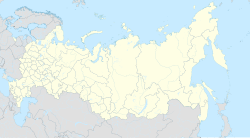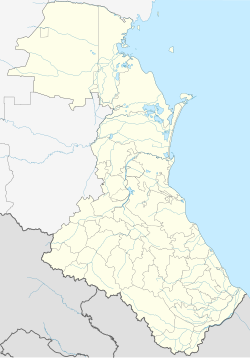Kalininaul, Kazbekovsky District, Republic of Dagestan
Kalininaul
Калининаул | |
|---|---|
| Other transcription(s) | |
| • Avar | Калининаул |
| • Chechen | Ширча-Ӏовх, Ширча-Эвла, Şirça-Evla |
 Views of Kalininaul | |
| Coordinates: 43°04′15″N 46°34′02″E / 43.07083°N 46.56722°E | |
| Country | Russia |
| Federal subject | Dagestan[1] |
| Administrative district | Kazbekovsky District[1] |
| Population | |
• Total | 4,531 |
| Time zone | UTC+3 (MSK |
| Postal code(s)[3] | |
| OKTMO ID | 82622440101 |
Kalininaul Until 1944 Yurt-Aukh[4] (Russian: Калининаул, Until 1944 Russian: Юрт-Аух; Chechen: Ширча-Ӏовх[5][6]) is a rural locality (a selo) in Kazbekovsky District of the Republic of Dagestan, Russia, located on the right bank of the Aktas River, at the confluence with the Sala-su River, opposite the selo of Leninaul, 18 kilometers (11 mi) south of Khasavyurt on the border with the Chechen Republic. Population: 4,531 (2010 Census);[1] 4,439 (2002 Census);[7] predominantly Chechen.
History
[edit]The oldest village of Chechens in the Terco-Sulak Meternrech. It was previously known as Shircha-Evla, Yurt-Evla, and Yurt-Aukh.
Yurt-Aukh, as it was then called, was until 1944 a part of the Aukh District. In 1944, during the deportation of Chechens to Central Asia, the locals were deported and Avars from the neighboring selo of Almak settled in their place.
In 1956, the Chechens were allowed to return to the Caucasus, but the local authorities prohibited their return directly to their ancestral villages in former Aukh District. Only several years later the Chechens were able to start buying back their houses from the Avars.
On August 27, 2007, a clash between over one hundred Chechens and Avars took place in Kalininaul, resulting in eight people injured.
Infrastructure
[edit]An elementary and a secondary school operate in Kalininaul. There is also a House of Culture, a post office, a kindergarten, and four mosques (two Chechen and two Avar).
Teips
[edit]The village is inhabited by the following chechen teips (clans):[citation needed]
Mosque of the 20th century
[edit]
In the old center of the village there is a functioning "Mosque in Yurt-Aukh", built at the beginning of the 20th century, is an architectural monument of Aukha. According to the stories of old-timers of the village, the mosque was built on the site where there was a need for clay, a new one arose due to the fact that the population of the village increased, and the old mosque could no longer accommodate everyone who wanted to, when building the mosque, the villagers hired builders for a certain fee.
Brick blocks were made of large sand stones, which local residents brought from the foot of the mountain Gebek-Kale on carts, the stones were carried one by one by harnessed horses and processed. Lime mortar was used as a solution for binding the blocks-stones, the contents of chicken eggs were added to it, which greatly increased the adhesion of the microparticles of the solution, giving the structure the strength of the monolith of the mosque.
In honor of the villagers who made the most significant contributions, name blocks were made, painted with different patterns and carved with names in the Arabic alphabet. The mosque has two main entrances, above one of which is depicted a horse and a man killing a snake with a sabre, and on the second arch is the Star of David and a drawing of a lion.[8]
References
[edit]- ^ a b c d e f Russian Federal State Statistics Service (2011). Всероссийская перепись населения 2010 года. Том 1 [2010 All-Russian Population Census, vol. 1]. Всероссийская перепись населения 2010 года [2010 All-Russia Population Census] (in Russian). Federal State Statistics Service.
- ^ "Об исчислении времени". Официальный интернет-портал правовой информации (in Russian). June 3, 2011. Retrieved January 19, 2019.
- ^ Почта России. Информационно-вычислительный центр ОАСУ РПО. (Russian Post). Поиск объектов почтовой связи (Postal Objects Search) (in Russian)
- ^ 1941 American Caucasus Map of 1941
- ^ Ахмадов 2009, p. 188.
- ^ Мусаев З. М. Чеченский тайп аккой — 2017. — 17 ноября.
- ^ Federal State Statistics Service (May 21, 2004). Численность населения России, субъектов Российской Федерации в составе федеральных округов, районов, городских поселений, сельских населённых пунктов – районных центров и сельских населённых пунктов с населением 3 тысячи и более человек [Population of Russia, Its Federal Districts, Federal Subjects, Districts, Urban Localities, Rural Localities—Administrative Centers, and Rural Localities with Population of Over 3,000] (XLS). Всероссийская перепись населения 2002 года [All-Russia Population Census of 2002] (in Russian).
- ^ "Памятник архитектуры ХХ века действующая мечеть в с . Юрт-Аух". ИА Чеченинфо (in Russian). Retrieved May 15, 2025.
Literature
[edit]- Ахмадов, Я. З. (2009). Очерк исторической географии и этнополитического развития Чечни в XVI-XVIII веках. Москва. ISBN 978-5-91821-013-0.
{{cite book}}: CS1 maint: location missing publisher (link)



